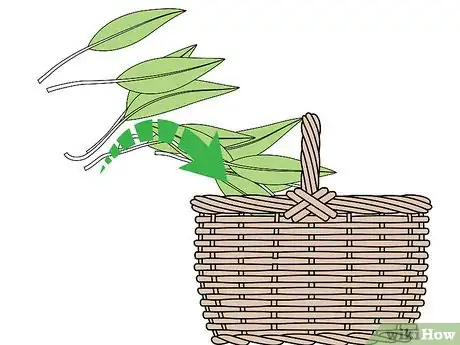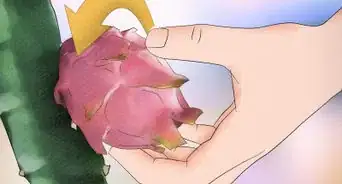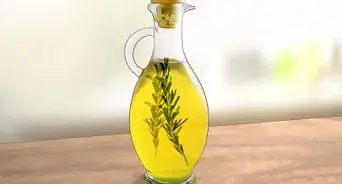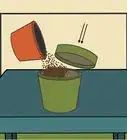This article was co-authored by Lauren Kurtz. Lauren Kurtz is a Naturalist and Horticultural Specialist. Lauren has worked for Aurora, Colorado managing the Water-Wise Garden at Aurora Municipal Center for the Water Conservation Department. She earned a BA in Environmental and Sustainability Studies from Western Michigan University in 2014.
There are 7 references cited in this article, which can be found at the bottom of the page.
This article has been viewed 41,272 times.
Wild garlic is an abundant plant in spring. The entire plant can be used as an herb or garnish. Identify wild garlic by its white flower clusters, stalk bunches, and distinct garlic and chive smell. Cut off the parts of the plant you want and layer them loosely in a basket or other container. At home, wash the garlic in cold water and enjoy it fresh or store it for later use.
Steps
Identification
-
1Search shady, damp areas. Wild garlic grows in spring around areas partially shaded. The plant also prefers damp ground, so follow water runoff. Common locations include woodlands, riverbanks, and country lanes.[1]
-
2Look for clusters of white flowers. Wild garlic will have a cluster of flowers at the end of a single stem. The flowers look like white stars with six petals each. Lily of the valley is closest in appearance to wild garlic, but can be distinguished by careful observation. Lily of the valley flowers are bell-shaped and droop downwards from the stem.[2]
- Lily of the valley is poisonous, so take your time while harvesting to make sure you pick the right plant.
Advertisement -
3Check for leaves low on stem bunches. Wild garlic has clusters of stems coming out of the ground. The stems are green and white. Leaves grow near the ground and are long, flat, and have a single vein down the middle. The leaves grow one per stem.
- Lily of the valley has one stem colored green and purple with two or three leaves.
-
4Check to see if you can smell wild garlic. When you're near some wild garlic, you'll probably be able to detect a garlic and chive smell. You can double-check by picking up and rubbing a garlic leaf between your fingers. This will release the same odor.[3]
- Lily of the valley and other plants won’t have this odor and may smell sweet instead.
Cutting
-
1Pick large and healthy leaves. The leaves will be near the ground. Pick or cut off mid-sized and large ones that look full and green. Leave the small leaves to replenish the plant.[4]
- The entire plant can be used, but the underground bulbs tend to be small. Removing the bulb should only be done if you have the landowner’s permission or don’t mind removing your own plant.
-
2Cut off tender stems. Try to cut the stems close to the ground using a knife or scissors. If you have a difficult time removing them, they will also be tough to eat unless cooked for a long time.[5]
-
3Harvest flowers. Unopened flowers can be used, but flowers that have bloomed have an even stronger taste than the leaves. Pluck them or snip them off with scissors. As spring passes, the flowers turn into seed pods which also have a strong flavor and can be eaten.[6]
-
4Lay pickings in a basket. Wild garlic clippings are delicate and leave a strong smell when damaged. While you can stuff them into a jacket, it is better to give them space. Line them in your basket and don’t press down.
- You may also put clippings into a plastic bag or water bottle. Keep them loosely packed and don’t squish them.
Storing
-
1Wash the clippings in cold water. Shake flowers to remove insects. At the very least, wash off the plant under cold, running water. You can fill a bowl with cold water and submerge the clippings for five minutes to prepare them for refrigeration.[7]
-
2Seal and refrigerate leftovers. Anything you won’t use immediately can be stored for about a week. You may wrap the washed clippings in a damp paper towel first to help them stay preserved. Place them in sealed plastic bags or covered containers.[8]
-
3Blanche and freeze wild garlic for longer storage. Boil a pot of water. Add the garlic. After a minute, remove the garlic to a bowl of ice cold water. Once the clippings are all in the water, begin moving them to freezer bags. Squeeze out as much air from the bags as possible. This garlic will last for months but will not be crisp.
- You can remove more air from the bag by using a soda straw. Close the bag around the straw. Suck out as much air as possible, then quickly remove the straw and close the bag.
-
4Bake leaves to create a dried herb. Spread the leaves out on baking sheets. Set the oven to the lowest possible heat setting. You may leave the oven door open if you are worried about them drying out too quickly. After about four hours, or when the leaves feel brittle, place them in airtight jars.
- You can also use a food dehydrator to dry out the leaves.
-
5Preserve leaves in oil or vinegar. Oil-preserving is good for sauces such as pesto. Simply chop or blend leaves in a food processor. Place them in jars, making sure they are covered by olive oil. Alternatively, cover the leaves with vinegar mixed with your favorite spice combination.[9]
- Oil-preserve garlic should be refrigerated and will last up to three weeks. Raw garlic pickled in vinegar can be left at room temperature but will last almost indefinitely in the refrigerator.
Community Q&A
-
QuestionHave garlic growing that came from a garlic seed pod years ago. They grow every year but the bulbs don't grow bigger. Each plant makes a white tea drop then pod of seeds. Is it wild garlic?
 Community AnswerIf these plants came from a conventional garlic seed pod for sure, they're garlic. The curly bits that emerge with "tear drops" you see are actually called garlic scapes and you need to remove them if you want bigger garlic bulbs. Snap this curly growth off at the base when it's roughly the size of a (bendy) pencil. You can do this with wild garlic too. But if you remember planting the garlic as garlic, nothing has changed.
Community AnswerIf these plants came from a conventional garlic seed pod for sure, they're garlic. The curly bits that emerge with "tear drops" you see are actually called garlic scapes and you need to remove them if you want bigger garlic bulbs. Snap this curly growth off at the base when it's roughly the size of a (bendy) pencil. You can do this with wild garlic too. But if you remember planting the garlic as garlic, nothing has changed.
Warnings
- Wild garlic can be mistaken for lily of the valley, which is toxic. Pay attention to the plant’s smell and appearance.⧼thumbs_response⧽
- Wild garlic can also grow among other toxic plants. Make sure the leaves you pick look and smell like those from the garlic plant.⧼thumbs_response⧽
- Bring a plant identification guide with you to help you differentiate wild garlic from toxic plants.⧼thumbs_response⧽
Things You’ll Need
- Scissors or a sharp knife
- A basket, plastic bag, or other storage container
- Cold water
- A kitchen towel
- Refrigerator or freezer containers
References
- ↑ http://www.telegraph.co.uk/men/active/10833740/Get-out-more-a-beginners-guide-to-wild-garlic.html
- ↑ http://www.hedgerow-harvest.com/2016/03/02/go-wild-for-the-wild-garlic/
- ↑ http://www.self-sufficient.co.uk/Wild-Garlic.htm
- ↑ http://www.telegraph.co.uk/men/active/10833740/Get-out-more-a-beginners-guide-to-wild-garlic.html
- ↑ http://www.foragingtexas.com/2008/08/onion-wild.html
- ↑ http://www.hedgerow-harvest.com/2016/03/02/go-wild-for-the-wild-garlic/
- ↑ https://scottishforestgarden.wordpress.com/2013/04/19/growing-and-eating-wild-garlic/
- ↑ http://honest-food.net/how-to-harvest-wild-onions/
- ↑ https://www.eatweeds.co.uk/wild-garlic-in-oil








































































